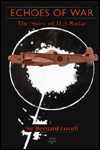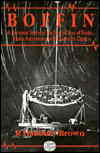Early Experiments
ASV Mk.I
When radar was developed in Britain in the late 1930s it was clear that any airborne radar had to be vastly different from the gigantic "Chain Home" radar masts that gave early warning to Britain's fighter defense. A dipole antenna operates best when its length is half the wavelength of the radar beam, and to direct the beam in any direction a large array of dipoles is required. Obviously, the number and length of the dipoles would be very limited in an airborne installation. However, at that time there was no sufficiently powerful source of short waves. To be useful, an airborne radar also needed to have a short minimum range, that is, it had to guide the aircraft close enough for its crew to see the target. This could be achieved by using shorter pulses than land radars.
There was little difference, at that time, between the development of AI (airborne intercept, i.e. radar for nightfighter) and ASV (airborne surface vessel, radar for maritime patrol aircraft). In 1938 and 1939, ASV radar had the higher priority.
On 17 August 1937, the very first British airborne radar was flown. Based on the Western Electric 316A valve, it generated 100 Watts of power at a wavelength of 1.25 meters, and was later improved by increasing the wavelength to 1.5 meters. Installed in Avro Anson K6260, this radar proved that it was capable of tracking the aircraft carrier HMS Courageous, the battleship HMS Rodney, and the cruiser HMS Southampton, in weather conditions that would have made conventional reconnaissance impossible. It even detected aircraft taking off from HMS Courageous.
The radar was not yet ready for service, however. Development was delayed by what Dr E.G. "Taffy" Bowen, head of the airborne radar group, described as "totally inadequate resources and virtually no administrative back-up." Finally, two antenna configurations were developed for ASV radar. One used a dipole transmitting antenna with a reflector to give a broad beam in the forward direction. The two receiving antennas were on the aircraft's wings, and their polar diagrams overlapped. The direction of the target was determined by comparing the signals from the two receivers, displayed together on a cathode-ray tube, one to the left of the (vertical) baseline and the other to the right. If the target was on the right then the right receiver gave the stronger signal. The vertical timebase indicated the distance to the target. This system gave a range of 10 miles on a 1000 ton ship, and up to 40 miles on a coastline with steep cliffs.
This was introduced as the first ASV radar (Mk.I), and installed on the Hudsons of Coastal Command. By the end of 1940 it was fitted in 24 Hudsons and 25 Sunderlands. About 200 sets were produced. Experience with it was not very good. The radar was unreliable and new equipment, and the manufacturing standard of many components left a lot to be desired. The problems of maintenance and training were enormous. Its usefulness and popularity were increased by Sqdn. Ldr. Lugg, who installed a 1.5 meter beacon at Leuchars. ASV Mk.I then was, at least, useful navigation equipment.
ASV Mk.I was not intended to detect submarines, but after an enquiry from admiral Somerville in late 1939 test were conducted with one of the Hudsons of No.220 Sqdn and the submarine L 27. It was demonstrated that, flying at 1000 feet, the submarine could be detected at 3 miles, broadside on, and this under experimental conditions --- that means that the crew of the Hudson knew exactly where the submarine was. Further tests revealed that when flying at 6000 feet, the range was increased to 6 miles.
A notable improvement was achieved with what called Long Range ASV. LRASV was based on the second antenna configuration developed. It was a sideways-looking system. The transmitter was an array of ten dipoles, installed in five (later reduced to four) pairs on top of the fuselage of the aircraft. The receiving antennas were Sterba arrays, fitted to the sides of the fuselage. Because the transmitter array was a dipole array 18 feet long and the two receivers were arrays 12 feet long, a much better resolution and range could be achieved. The first installation was on a Whitley bomber, in late 1939. LRASV had a range 2.5 times better than the forward-looking system; it could detect submarines at 10 to 15 miles.
ASV Mk.II
Developed at the Royal Aircraft Establishment at Farnborough in early 1940, ASV Mk.II differed from Mk.I mainly because it was properly engineered, and therefore much more reliable. Although called a 1.5m radar, it actually used 1.7m (176MHz). Range was up to 36 miles. The minimum range was about a mile. Several thousand sets were built, and installed in Hudsons, Sunderlands, Wellingtons, Beauforts, Warwicks, Whitleys, Liberators, and other Coastal Command aircraft. ASV Mk.II was used with both the forward-looking and the sideways-looking LRASV configuration, production being divided approximately equal. Only the LRASV was useful against submarines.
The first success was recorded on 30 November 1940, when a Whitley Mk.VI equipped with ASV damaged U-71 in the Bay of Biscay. By mid-1941 the ASV radar had increased daytime attacks on U-boats by 20%, and made nightly attacks possible.
However, night attacks were generally ineffective, for the simple reason that the aircraft crew could not see the submarine. The radar guided them to a mile of the submarine, but not closer. On 21 December 1941 an ASV-equipped Swordfish made the first successful night attack on an U-boat, but such remained exceptions.
ASV Mk.III
By late 1942, the U-boats carried "Metox", a simple radio receiver, which enabled them to detect the ASV Mk.II radar. This reduced the efficiency of the ASV equipped aircraft considerably, and shipping losses increased again.
The history of ASV Mk.III is rather complicated. Because of personal conflicts, the original group that had developed airborne radar was dispersed. A new team was formed, tasked with the development of centimetric AI radar for nightfighters. The big advantage of a centimetric radar is that the beam can be directed accurately by a relatively small paraboloid reflector. This offered better range and resolution and eliminated the strong ground returns, which were unavoidable with the broad beams of the 1.5 meter radar sets. Centimetric radar was made possible by the development, by J.T. Randall and H.A.H. Boot, of the cavity magnetron. The first was tested on 21 February 1940. By June 1940, GEC had produced the first sealed magnetrons, suitable for use in aircraft.
Development concentrated on AI for nightfighthers, but in the autumn of 1940 the 10cm radar attracted naval interest, represented by Captain B.R. Willett and C.E. Horton. It was demonstrated to them that the ground-based, experimental radar equipment could track ships. On 11 November tests were conducted with the submarine HMS Usk, which was tracked at 7 miles. Some time was spent refining the equipment and defining the antennas, until a cylindrical paroboloid section was chosen for shipboard installations. By March 1941, a fully engineered 10cm radar was on board of the corvette HMS Orchis, and on 16 November 1941 the sinking of U-433 near Gibraltar was attributed to the "Type 271" 10cm radar. By May 1942, 236 ships carried centimetric radar.
Meanwhile, the development of centimetric AI had continued, and in March 1942 it entered operational service. Known as AI Mk.VII, this was a remarkable achievement, and by August 1942 a fully-engineered production model followed, AI Mk.VIII. Tests against submarines had been conducted in April 1941, against HMS Sea Lion, and in August, against HMS Sokol. The radar was effective, but development of the ASV version was slow, much slower than that of AI radar, and the first experimental, centimetric ASV radar was not test flown before December 1941. By the summer of 1942 this so-called ASVS radar was being productionized by Ferranti. But then, on 30 September 1942, Ferranti was told to halt the work. Work on ASVS was stopped, much to the dismay of Coastal Command.
The reason for this decision was that at the same time, H2S ground-mapping radar was under development for Bomber Command. The two systems had many similarities, and H2S was closer to production. The first test of a ground-mapping centimetric radar had been made on 1 November 1941, and was impressively succesful. A more practical system was flying in a Halifax on 17 March 1942, and immediately attracted the attention of a endless parade of high-ranking officers. This culminated in meeting on Downing Street 10 on 3 July, where Churchill insisted that he wanted 200 sets operational by mid-October. At that time, there was no working H2S radar at all, because the Halifax had crashed. There were still considerable problems in designing the H2S scanner, and it had not yet been resolved whether a cavity magnetron or a klystron would be used to generate the microwave power. The klystron provided insufficient power, but the use of the cavity magnetron meant that it would certainly fall in German hands. By 15 July, it had been decided to use the magnetron anyway. Development was enhanced by the valuable support of Sir Robert Renwick, appointed by Churchill to oversee H2S development, and by Group Captain D.C.T. Bennet, commander of No.8 Group, the "Pathfinder Force" of Bomber Command. By September, a version was ready for service trials. At the end of 1942, 24 bombers, Halifaxes and Stirlings, carried H2S.
Of course H2S Mk.I had been designed for four-engined bombers flying at 20,000 feet, and a hasty demonstration over sea was an annoying failure. Obviously, the system needed to be redesigned for operations at 2,000 feet. This did little to improve the attitude of Coastal Command towards this new radar system, which already suffered from being "not invented here". To some extent to irritation of Coastal Command was justified: There were to be fierce conflicts with Bomber Command over the allocation of radar equipment to H2S and ASV.
In any case, Coastal Command was not going to get any of the four-engined "heavies", so the first installation was made in a twin-engined Wellington bomber. The radar was installled in the nose, with the size of the scanner reflector reduced to 28 inches. This gave a 60 degree field of view in front of the aircraft. The display was the now familiar PPI (Plan Position Indicator), which presented a 'map view' of the relative positions. Coastal Command was still less than eager to support the system, and this slowed development. On 1 March 1943 a Wellington of No.172 Sqdn flew the first patrol over the Bay of Biscay. On 17 March they saw their first U-boat at 9 miles, but the Leigh light failed and the first attack was made on the next day. At the end of March 13 sightings had been made.
By May, Coastal Command detected and attacked most U-boats in the Bay of Biscay. U-boat sightings improved dramatically, and shipping losses decreased drastically, from 400,000 to 100,000 tons per month. Doenitz ordered his submarines to stay on the surface and fight it out with aircraft, but he lost 56 U-boats in April and May. Doenitz reported that the situation had become "impossible". This "temporary setback" was significant enough to be mentioned in a speech by Hitler. This result had actually been achieved by a handful of aircraft equipped with ASV Mk.III.
Meanwhile in the USA, a 10cm ASV radar called DMS-1000 had been developed by the Radiation Laboratory. It was installed in Liberators, but although the first one arrived in the UK in March 1942, it still lacked the Leigh light. The Liberator was used operationally in early 1943, and by the summer the Liberators were closing the "Atlantic gap". Everywhere in the Atlantic, U-boats could now be attacked by ASV-equipped aircraft.
ASV Mk.VI
The British anticipated that the Germans would develop a warning detector for the 10cm ASV, as they had done for the 1.5 meter ASV. (They indeed did, the Naxos system, but it appeared three months after the first use of centimetric ASV radar. It seems that during the interrogation of a captured British officer, the Germans were told that the British were actually detecting the weak emissions of Metox. As this was technically possible, it was believed.)
Therefore ASV Mk.VI was developed. It was more powerful than Mk.III, but it had an attenuator (called Vixen) fitted. The idea was to reduce the power once the U-boat had been detected, so that the operator of any detection device would be fooled into believing that the aircraft was flying away, or at least not coming closer. Development of Mk.VI was once again slowed down by administrative obstructions. On 23 October 1943 Air Marshall Sir John Slessor, then head of Coastal Command, heard about this. Slessor was convinced that the Germans already had a detector for the 10cm radar (they had), and he reacted by writing a very angry letter in which called for disciplinary action, and used terms such as "crass stupidity" and "congenital idiot". Despite whispers about Slessor's imminent court-martial, this managed to create some activity in the Air Ministry. (Coastal Command lost the fight to get the 3cm ASV Mk.VII, however. All 3cm equipment was allocated to Bomber Command.)
There was also ASV Mk.VIA, which allowed the aircraft to lock onto the U-boat and aim its Leigh light directly at it. But this was not ready before the summer of 1944. The even more developed ASV MK.VIB made blind bombing possible.
ASV Mk.VII
The Mk.VII system was a development of a 3cm H2S system. This too was planned in anticipation of a German detector for 10cm waves. However, Bomber Command refused to accept any reduction in its deliveries of the 3cm H2S. When an agreement was reached to release some 3cm radars to Coastal Command, the commander of Bomber Command, A. Harris, telephoned Churchill and managed to reverse the decision. As a consequence, ASV Mk.VII had a low priority, and this decreased even more when the defeat of the U-boats became clear and the ports on the French coast were taken by Allied forces.
But in October 1944, the Allied became aware of two worrying developments: The appearance of a new class of U-boats, and the fitting of the "Schnorkel" to U-boats. The latter was virtually undetectable by 10cm ASV radar. In a meeting on 22 November, it was decided that developments of the 3cm ASV radar offered the best hopes, although experiments with 1.25cm radars were also conducted. The work was undertaken both in Britain, under the aegis of B.J. O'Kane, and in the USA, where the US Navy started the aptly called "Project Hawkeye" in the Radiation Laboratory of the MIT. However, the tests were not concluded before the end of the war.
ASV Mk.XI
The ASV Mk.XI was a centrimetric radar intended for the TBR (torpedo bomber and reconnaissance) aircraft of the Fleet Air Arm, the component of the Royal Navy that operated carrier aircraft. It was also known known as ASVX and therefore it sometimes has been called, erroneously, ASV Mk.X.
ASV Mk.XI could be fitted between the main wheel legs of a Fairey Swordfish. In addition to the bulky radome, a Leigh light could be fitted. The radome made the the carrying of torpedoes or large depth charges impossible, so when the target was a ship the Swordfish was accompanied by other aircraft without radar. Against submarines, the radar-equipped Swordfish Mk.III was armed with eight rockets on underwing launches, and also carried flares to illuminate any U-boat it found. Fired at 600 yards, the rockets easily penetrated a submarine's hull.
This radar was also carried by the Fairey Barracuda Mk.III.
ASV Mk.XI had a maximum range of about 60km against ships, and in good conditions and at low altitude (2000 feet) it could detect a surfaced submarine at about 20km. But it could detect a schnorkel only in very calm seas and at distances below 8km. It gave bearings with an accuracy of about 2 degrees.
Other Allied Radars
Unfortunately, I don't have any source with detail about US radars. The following were certainly in use by maritime aircraft:
| AN/APS-2 | |
| AN/APS-3 | Carried by the Grumman OA-10 |
| AN/APS-15 | H2X |
| AN/APS-20 | Carried by the PB-1W and TBM-3W |
Magnetic Airborne Detectors
These were in use during WWII, but I find very little information about them.
Sources
- Avionics -- The Story and technology of aviation
electronics
Bill Gunston, published by Patrick Stephens Limited, 1990. - Boffin -- A Personal Story of the Early Days of Radar,
Radio
Astronomy and Quantum Optics
R Hanbury Brown, published by Adam Hilger, 1991. - Echoes of War -- The Story of H2S Radar
Sir Bernard Lovell, published by Adam Hilger, 1991. - Wings of the Navy
Capt. Eric Brown, published by Pilot Press, 1980. - Across the Ether
Stephen Pope, in Aeroplane Monthly, June 1995.
-> Article includes pictures of aircraft with ASV radar and a picture of the Leigh light. - Brian Wood sent us information on the ASV Mk.XI radar from the original manual.
Selected media links
|
|
|






